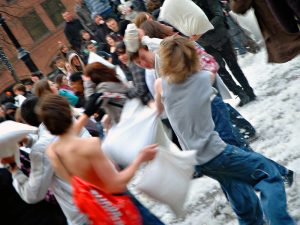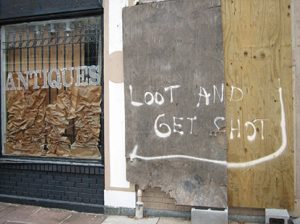Collective Behavior
- Describe different forms of collective behavior
- Differentiate between types of crowds
- Discuss emergent norm, value-added, and assembling perspective analyses of collective behavior
Flash Mobs

In March 2014, a group of musicians got together in a fish market in Odessa for a spontaneous performance of Beethoven’s “Ode to Joy” from his Ninth Symphony. While tensions were building over Ukraine’s efforts to join the European Union, and even as Russian troops had taken control of the Ukrainian airbase in Belbek, the Odessa Philharmonic Orchestra and Opera Chorus tried to lighten the troubled times for shoppers with music and song.
Spontaneous gatherings like this are called flash mobs. They often are captured on video and shared on the Internet; frequently they go viral. Humans seek connections and shared experiences. Perhaps experiencing a flash mob event enhances this bond. It certainly interrupts our otherwise mundane routine with a reminder that we are social animals.
Forms of Collective Behavior
Flash mobs are examples of collective behavior, noninstitutionalized activity in which several or many people voluntarily engage. Other examples are a group of commuters traveling home from work and a population of teens adopting a favorite singer’s hairstyle. In short, collective behavior is any group behavior that is not mandated or regulated by an institution. There are three primary forms of collective behavior: the crowd, the mass, and the public.
It takes a fairly large number of people in close proximity to form a crowd (Lofland 1993). Examples include a group of people attending an Ani DiFranco concert, tailgating at a Patriots game, or attending a worship service. Turner and Killian (1993) identified four types of crowds. Casual crowds consist of people who are in the same place at the same time but who aren’t really interacting, such as people standing in line at the post office. Conventional crowds are those who come together for a scheduled event that occurs regularly, like a religious service. Expressive crowds are people who join together to express emotion, often at funerals, weddings, or the like. The final type, acting crowds, focuses on a specific goal or action, such as a protest movement or riot.
In addition to the different types of crowds, collective groups can also be identified in two other ways. A mass is a relatively large number of people with a common interest, though they may not be in close proximity (Lofland 1993), such as players of the popular Facebook game Farmville. A public, on the other hand, is an unorganized, relatively diffused group of people who share ideas, such as the Libertarian political party. While these two types of crowds are similar, they are not the same. To distinguish between them, remember that members of a mass share interests, whereas members of a public share ideas.
Theoretical Perspectives on Collective Behavior
Early collective behavior theories (LeBon 1895; Blumer 1969) focused on the irrationality of crowds. Eventually, those theorists who viewed crowds as uncontrolled groups of irrational people were supplanted by theorists who viewed the behavior some crowds engaged in as the rational behavior of logical beings.
Emergent-Norm Perspective

Sociologists Ralph Turner and Lewis Killian (1993) built on earlier sociological ideas and developed what is known as emergent norm theory. They believe that the norms experienced by people in a crowd may be disparate and fluctuating. They emphasize the importance of these norms in shaping crowd behavior, especially those norms that shift quickly in response to changing external factors. Emergent norm theory asserts that, in this circumstance, people perceive and respond to the crowd situation with their particular (individual) set of norms, which may change as the crowd experience evolves. This focus on the individual component of interaction reflects a symbolic interactionist perspective.
For Turner and Killian, the process begins when individuals suddenly find themselves in a new situation, or when an existing situation suddenly becomes strange or unfamiliar. For example, think about human behavior during Hurricane Katrina. New Orleans was decimated and people were trapped without supplies or a way to evacuate. In these extraordinary circumstances, what outsiders saw as “looting” was defined by those involved as seeking needed supplies for survival. Normally, individuals would not wade into a corner gas station and take canned goods without paying, but given that they were suddenly in a greatly changed situation, they established a norm that they felt was reasonable.
Once individuals find themselves in a situation ungoverned by previously established norms, they interact in small groups to develop new guidelines on how to behave. According to the emergent-norm perspective, crowds are not viewed as irrational, impulsive, uncontrolled groups. Instead, norms develop and are accepted as they fit the situation. While this theory offers insight into why norms develop, it leaves undefined the nature of norms, how they come to be accepted by the crowd, and how they spread through the crowd.
Value-Added Theory
Neil Smelser’s (1962) meticulous categorization of crowd behavior, called value-added theory, is a perspective within the functionalist tradition based on the idea that several conditions must be in place for collective behavior to occur. Each condition adds to the likelihood that collective behavior will occur. The first condition is structural conduciveness, which occurs when people are aware of the problem and have the opportunity to gather, ideally in an open area. Structural strain, the second condition, refers to people’s expectations about the situation at hand being unmet, causing tension and strain. The next condition is the growth and spread of a generalized belief, wherein a problem is clearly identified and attributed to a person or group.
Fourth, precipitating factors spur collective behavior; this is the emergence of a dramatic event. The fifth condition is mobilization for action, when leaders emerge to direct a crowd to action. The final condition relates to action by the agents. Called social control, it is the only way to end the collective behavior episode (Smelser 1962).
A real-life example of these conditions occurred after the fatal police shooting of teenager Michael Brown, an unarmed eighteen-year-old African American, in Ferguson, MO on August 9, 2014. The shooting drew national attention almost immediately. A large group of mostly black, local residents assembled in protest—a classic example of structural conduciveness. When the community perceived that the police were not acting in the people’s interest and were withholding the name of the officer, structural strain became evident. A growing generalized belief evolved as the crowd of protesters were met with heavily armed police in military-style protective uniforms accompanied by an armored vehicle. The precipitating factor of the arrival of the police spurred greater collective behavior as the residents mobilized by assembling a parade down the street. Ultimately they were met with tear gas, pepper spray, and rubber bullets used by the police acting as agents of social control. The element of social control escalated over the following days until August 18, when the governor called in the National Guard.

Assembling Perspective
Interactionist sociologist Clark McPhail (1991) developed assembling perspective, another system for understanding collective behavior that credited individuals in crowds as rational beings. Unlike previous theories, this theory refocuses attention from collective behavior to collective action. Remember that collective behavior is a noninstitutionalized gathering, whereas collective action is based on a shared interest. McPhail’s theory focused primarily on the processes associated with crowd behavior, plus the lifecycle of gatherings. He identified several instances of convergent or collective behavior, as shown on the chart below.
| Type of crowd | Description | Example |
|---|---|---|
| Convergence clusters | Family and friends who travel together | Carpooling parents take several children to the movies |
| Convergent orientation | Group all facing the same direction | A semi-circle around a stage |
| Collective vocalization | Sounds or noises made collectively | Screams on a roller coaster |
| Collective verbalization | Collective and simultaneous participation in a speech or song | Pledge of Allegiance in the school classroom |
| Collective gesticulation | Body parts forming symbols | The YMCA dance |
| Collective manipulation | Objects collectively moved around | Holding signs at a protest rally |
| Collective locomotion | The direction and rate of movement to the event | Children running to an ice cream truck |
As useful as this is for understanding the components of how crowds come together, many sociologists criticize its lack of attention on the large cultural context of the described behaviors, instead focusing on individual actions.
Summary
Collective behavior is non-institutionalized activity in which several people voluntarily engage. There are three different forms of collective behavior: crowd, mass, and public. There are three main theories on collective behavior. The first, the emergent-norm perspective, emphasizes the importance of social norms in crowd behavior. The next, the value-added theory, is a functionalist perspective that states that several preconditions must be in place for collective behavior to occur. Finally the assembling perspective focuses on collective action rather than collective behavior, addressing the processes associated with crowd behavior and the lifecycle and various categories of gatherings.
References
Blumer, Herbert. 1969. “Collective Behavior.” Pp. 67–121 in Principles of Sociology, edited by A.M. Lee. New York: Barnes and Noble.
LeBon, Gustave. 1960 [1895]. The Crowd: A Study of the Popular Mind. New York: Viking Press.
Lofland, John. 1993. “Collective Behavior: The Elementary Forms.” Pp. 70–75 in Collective Behavior and Social Movements, edited by Russel Curtis and Benigno Aguirre. Boston: Allyn and Bacon.
McPhail, Clark. 1991. The Myth of the Madding Crowd. New York: Aldine de Gruyter.
Smelser, Neil J. 1963. Theory of Collective Behavior. New York: Free Press.
Turner, Ralph, and Lewis M. Killian. 1993. Collective Behavior. 4th ed. Englewood Cliffs, N. J., Prentice Hall.
a large group of people who gather together in a spontaneous activity that lasts a limited amount of time
a noninstitutionalized activity in which several people voluntarily engage
a fairly large number of people who share close proximity
people who share close proximity without really interacting
people who come together for a regularly scheduled event
crowds who share opportunities to express emotions
crowds of people who are focused on a specific action or goal
a relatively large group with a common interest, even if they may not be in close proximity
an unorganized, relatively diffuse group of people who share ideas
a perspective that emphasizes the importance of social norms in crowd behavior
a functionalist perspective theory that posits that several preconditions must be in place for collective behavior to occur
a theory that credits individuals in crowds as behaving as rational thinkers and views crowds as engaging in purposeful behavior and collective action

